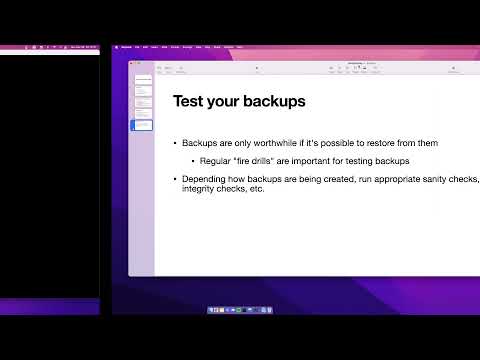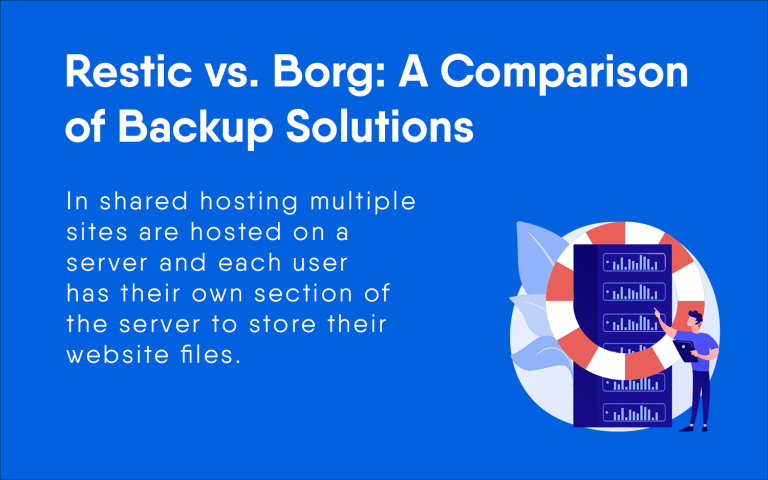Restic vs Borg vs Kopia: A Comprehensive Comparison
Restic, Borg and Kopia are three popular backup solutions that have gained prominence among techies. While all three tools aim to provide secure backups, they each possess specific advantages and drawbacks that set each apart from its peers. In this article we’ll compare Restic vs Borg vs Kopia by exploring their backup and restoration capabilities, performance/efficiency considerations, security / encryption measures available through cloud storage repositories as well as their respective community maturity status/expertise as well as community/maturity characteristics among others.

Restic and Borg are both well-regarded backup solutions that offer swift and efficient data backup and restoration processes, employing deduplication to reduce storage space usage while Borg employs its unique chunking algorithm for efficient backups. Recently introduced alternative Kopia may offer faster backups/restores than either of its rivals.
Performance and efficiency should also be key considerations when selecting a backup solution. Restic and Borg both boast highly efficient backup speeds; Restic tends to perform initial backups more quickly while Borg can backup incremental data faster. Kopia claims to outshone both in terms of both initial and incremental backup speeds; though performance may depend on factors like network speed, storage capacity capacity and size of data being backed up.
Key Takeaways
- Restic and Borg provide reliable backup solutions with fast, efficient backup and restoration processes.
- Kopia is an emerging backup solution that promises faster backups and restores than both Restic and Borg.
- When selecting a backup solution, it’s essential to consider factors like backup and restoration capabilities, performance efficiency, security features like encryption as well as community involvement and maturity.
Related Posts:
Backup and Restoration
Initial and Incremental Backups
Both Restic and Borg provide initial and incremental backup capabilities. An initial backup is the initial full copy taken of data; an incremental backup only backs up changes that have occurred since the last backup, saving both time and storage space by only backing up what needs protecting.
Restic and Borg both utilise deduplication to save space on storage systems, with Borg using more efficient implementation than Restic. Borg utilizes a content-defined chunking algorithm which divides data into smaller chunks which are then hashed; this ensures identical chunks only need be stored once even when appearing across backup copies, unlike Restic which employs fixed size chunking algorithms which may store more duplicated information.
Restoring Snapshots
Restoring snapshots involves recovering data from an earlier backup. Both Restic and Borg make the process easy for users, as Restic allows users to restore it either back into its original location or elsewhere, while Borg requires users to extract all backup files prior to restoring them, adding another layer of security as previously-backed up files are only accessible after being extracted from storage.
Kopia offers both initial and incremental backups, using a content-aware chunking algorithm similar to Borg’s that makes it more efficient than Restic. Furthermore, Kopia can take snapshot-based backups that take a snapshot of data prior to backing it up, thus guaranteeing consistency and the ability to restore any point in time from backups made using Kopia.
Kopia offers an easy and straightforward command-line interface to restore snapshots to their original locations, or anywhere in-between. Furthermore, mountable snapshots enable users to mount them as read-only filesystems and access files directly.
Overall, all three backup solutions provide reliable backup and restoration capabilities. Borg and Kopia tend to be more effective at deduplication and chunking algorithms compared with Restic, while both allow snapshot-based backups that ensure consistency as well as point-in-time restore capabilities.
Performance and Efficiency

CPU and RAM Utilization
When it comes to choosing between Restic, Borg, and Kopia backup solutions, one of the key aspects to keep in mind is their CPU and RAM utilization. Restic and Borg both consume considerable memory during backup processes which may limit systems with limited resources; Kopia utilizes less RAM, making it better suited for smaller systems.
Restic and Borg have both proven themselves as being CPU-heavy when performing backups, while Kopia utilizes less CPU power, making it the superior option for those looking to prioritize performance over capacity.
Compression and Deduplication
Compression and Deduplication Another key consideration when comparing these backup solutions is their compression and deduplication capabilities. Restic and Borg both employ this strategy to reduce backup sizes; however, their approaches differ.
Restic employs both compression and deduplication techniques to decrease backup storage size, while Borg employs more advanced deduplication algorithms that efficiently identify and delete duplicated data. Kopia, on the other hand, employs simpler deduplication algorithms with less resource requirements.
Benchmarking Results
Restic, Borg and Kopia each possess strengths and weaknesses when it comes to benchmarking. According to Hostinger’s benchmark test conducted during which they all competed, Restic was found to be faster at backing up large amounts of data than Borg whereas Kopia outshone both in this same benchmarking test.
Kasten conducted another benchmark test which demonstrated Kopia’s improvement since previous releases, decreasing backup times of 200GiB data from approximately 840 seconds to 200 seconds for Restic and 90GB for Kopia respectively.
Overall, Kopia stands out as a more efficient and capable backup option than Restic or Borg; particularly for smaller systems with limited resources.
Security and Encryption

Security and encryption are integral parts of backup solutions, so here we’ll look at how Restic, Borg and Kopia handle these processes.
Double Encryption
Restic’s double encryption capability stands out as one of its hallmark features, providing an extra layer of security against attackers trying to gain entry. By first using AES-256 GCM mode encryption for data, and then another layer using RSA-4096 for keys, Restic adds two levels of encryption – increasing protection while making it harder for attackers to gain entry to data.
Borg only utilizes AES-256 encryption; though still an effective standard, this lacks the double security offered by Restic’s double encrypting approach.
Kopia also utilizes AES-256 encryption, but provides more customization in terms of encryption modes available; you can choose among GCM, CBC and CTR modes for different encryption scenarios. While Kopia does not offer double encryption functionality as such, other security features include password protection and the ability to encrypt data at rest.
SSH Security
Each backup solution supports SSH for secure communication between the client and server. SSH provides encryption for data in transit while also authenticating users to prevent unauthorised access.
Restic and Borg both support SSH tunneling, which enables encrypted traffic between client and server even if the latter doesn’t natively support SSH. Kopia does not support tunneling but allows use of SSH keys for authentication.
Overall, Restic and Borg offer strong security and encryption features, with Restic’s double encryption providing extra protection. Kopia provides a good balance of security and usability; however it doesn’t offer as much protection as Restic or Borg.
Cloud Storage and Repositories

Cloud storage and repositories play an essential role when selecting a backup solution, and Restic, Borg and Kopia each support various providers and repositories.
AWS and S3 Buckets
Amazon Web Services (AWS) is one of the premier cloud storage providers, and all three backup solutions support AWS S3 buckets for backup purposes. Users of Restic, Borg, and Kopia can configure their credentials with AWS for use of S3 backups as backup solutions.
Restic has an edge over Borg and Kopia when it comes to S3 bucket support, offering S3 compatible APIs that make it compatible with other cloud storage providers such as DigitalOcean Spaces or Wasabi; both Borg and Kopia only support Amazon S3 buckets.
Backblaze B2 Storage
Backblaze B2 is another widely-used cloud storage provider, and all three backup solutions support it. Restic, Borg, and Kopia allow users to configure their Backblaze B2 credentials and utilize it for backup purposes.
Borg and Kopia stand out when it comes to Backblaze B2 support; both offer faster upload speeds and lower costs compared to Restic’s S3-compatible API used.
Overall, Restic, Borg and Kopia offer outstanding support for cloud storage providers and repositories; however, depending on an individual user’s specific requirements and preferences, one backup solution may be more suited than the others.
Community and Maturity

Reddit Discussions
For anyone comparing Restic, Borg, and Kopia backup solutions, Reddit can provide an invaluable forum of user conversations and opinion exchange. All three solutions have vibrant communities on Reddit where users share experiences while offering tips to those just getting started using their software.
Restic has an active Reddit community with many users posting and discussing, while Borg and Kopia both feature smaller but still helpful groups of members. Overall, users tend to be pleased with all three solutions, often commenting positively about them for their reliability and user-friendliness.
Program Maturity and Stability
Both Restic and Borg can be seen as mature solutions with respect to program maturity and stability, though Restic has been around longer, dating back to 2014. Both solutions have experienced multiple major releases since their releases as well as active community support for both.
Kopia is a relatively recent backup solution, having made its initial commit in 2018. Though considered reliable and secure, its development remains incomplete compared to Restic or Borg; nonetheless, Kopia has gained popularity among users thanks to its ease of use.
Overall, all three backup solutions enjoy vibrant communities and are considered stable and reliable solutions. While Restic and Borg have been around longer and are considered more mature solutions, Kopia is relatively newer but quickly gaining ground among users.
Conclusion

Restic, Borg and Kopia are three reliable backup solutions that each provide various features and benefits. Restic is well known for its fast backup times and efficient storage space utilization; however it has received criticism due to its high RAM usage. Borg on the other hand is noted for its lower memory usage as well as compression/deduplication capability across various platforms with user-friendly interface support for multiple operating systems. Meanwhile Kopia is a newer backup solution gaining popularity due to its ease of use.
Restic and Borg both perform similarly when it comes to backup size and storage utilization, since both systems de-duplicate and compress data. All three solutions have proven themselves reliable as evidenced by successful backups over the course of their existence.
At the core, choosing between Restic, Borg, and Kopia will depend on individual user needs and preferences. Restic may be ideal for users prioritizing fast backup times while Borg may be better for conserving memory usage. Kopia could be ideal if newcomers to backup software want an intuitive, user-friendly solution.
Before making their final choice, users are advised to carefully assess each backup solution and compare its features and benefits before making their decision.

Faisal Rafique
I’m an accomplished entrepreneur and content creator with a strong background in technology and software engineering. My expertise spans web development, eCommerce, programming, hosting management, technical support, and data science. I hold a Master’s Degree in Computer Science and Engineering, and I have over 5 years of professional experience, which I leverage to grow my digital business and popular blog, FaisalRafique.com



